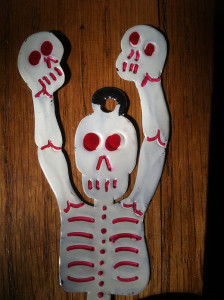Today is All Souls Day, the companion to All Saints. It is Dia de Muertos in Mexico, I Morti in Italy, and certainly there are other names in other places for these days of the dead. I think of All Saints Day (or All Hallows, where Halloween gets its name), which was yesterday, as the more pious of the two days. Both are holidays of the Church; All Hallows is the day we remember all the countless and nameless saints who have gone before us, the ones who don’t have a feast day in their name. Ognissanti is the name Italians give to the First of November: “every saint.” But the Second of November is the day we remember everyone else, the ones who perhaps weren’t so saintly. Which is most of us, no? No matter how kind and respectful we are, there’s always something about ourselves we can improve upon. And so I think of All Souls as the more familial of the two days. These are the souls we can relate to.
Traditional folk cultures have always had a healthy relationship with death. Death is part of life, after all. It may not be something we want to talk about, but ignoring it is, I think, to not fully engage life. Celebrations like I Morti and Dia de Muertos, and even Halloween, as it ushers in these days of the dead, give us some power to deal with reality. If death is part of the equation, we may as well have some fun with it. And so we bake Pan de Muertos (Bread of the Dead) and we drink Bone Punch and we make sugar skulls and we laugh and cry and in a way, for these few days, at least, no one is missing. We are all together, across time: the other world dwells within the world of the living.
One thing I’d like to stress right here from the start of this blog is that the Book of Days is not about fun and happiness, not all the time. Yes, if you know Seth and me and Convivio Bookworks, you know that we are pretty partial to a festive time. Good food and drink is at the heart of much of what we do. But while festivity is of great importance, I think it’s equally important to acknowledge that there is a concurrent thread of melancholy that wends its way through life. If we consider weaving fabric as an analogy, perhaps we can think of joy as the warp and sadness as the weft. You can’t weave cloth without both threads, and using both makes a pretty interesting weave. If the Book of Days was to focus only on joy, it would be one sappy book: all sugar (or worse, saccharine) and no substance. Joy and happiness are wonderful things, but it is important to set the stage for needing joy and happiness. So much about contemporary holiday celebrations focuses solely on the sweet and does not delve into the darker mysteries of the days. If you’ve ever met someone who dislikes Christmas or Halloween, for instance, this may be at the core of what they are feeling. Sugar coating reality irritates people. Don’t do it.
Here’s what’s going on in homes in Sicily today for I Morti: the children are running around the house looking for presents (usually sweets from the bakery) that their dead relatives have brought and hidden for them. This is their time to return to the world of the living, plunder bakeries, and hide treats for the kids. The dead are gift bearers, much like Father Christmas or Santa Lucia. In other parts of Italy, people are dining tonight on stews made with fava beans. These large beans have been associated with death since the days of the Roman Empire and are at the heart of meals this time of year. In some places, families will leave a spoonful or two of fava bean stew out on the windowsill for the dead to enjoy. And of course there are sweets: cookies in the shape of fava beans or of bones: fave dei morti and ossi dei morti (Fave of the Dead and Bones of the Dead).
In Mexico, of course, the celebration is fantastic, a combination of celebration and reverence. Families are enjoying picnics in cemeteries at the graves of their loved ones. There are ofrendas set up in homes, filled with cut paper (papel picado), clay calaveras, candies, candles, and marigolds, as well as photographs of the ones who have gone before. There are sugar skulls and the Pan de Muertos mentioned above. There is music and dancing (can’t you hear the marimba (rattling like bones) and the mariachi?) Talk about a healthy relationship with death!
This all derives from the Celts, for whom this time was the close of one year and the start of a new: Samhain, the ancient Celtic new year. It is the start of winter by the Celtic calendar… and by traditional reckoning of time. We are about halfway now between the Autumnal Equinox and the Winter Solstice and these gateway days were/are considered times when the bridges between the physical and spiritual worlds were more easily crossed. Or think of them as the worlds of the living and of the dead. Or of the visible and the unseen. These are the traditions that inform so much of what goes on these three days of late October and early November. The Church turned Samhain into All Hallows so many centuries ago (one of the Church’s earliest proclaimed holidays, dating to the Seventh Century), and we celebrate it still today. And if we honor these days of the dead with reverence and yes, celebration, then we’ve done well in building that healthy relationship with reality and with weaving those strands of melancholy and joy. In the process, we find ourselves more complete.

Like the new bigger font. Like the sentiment even more. Thanks guys.